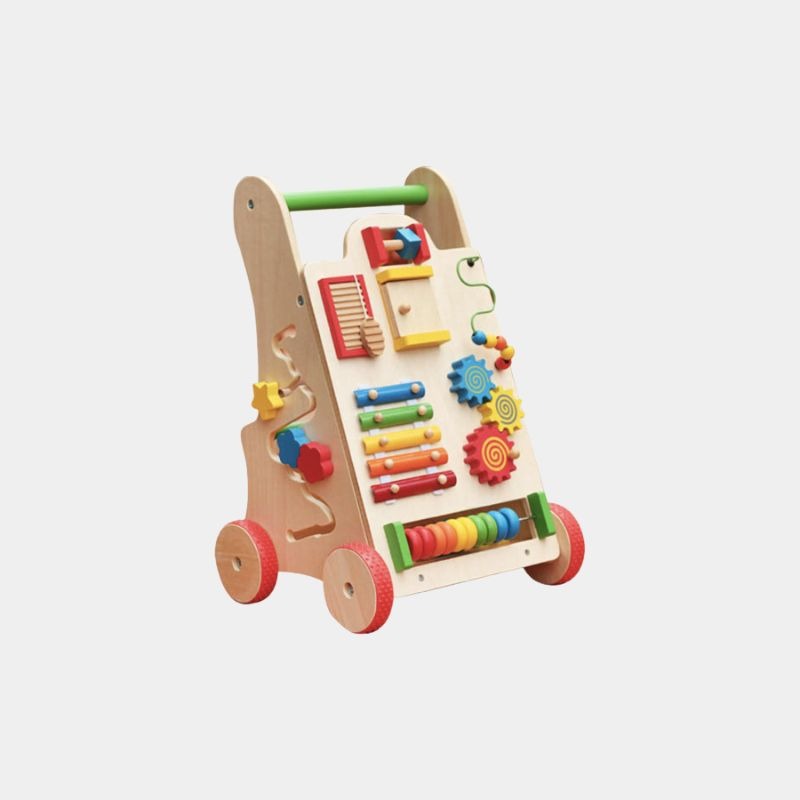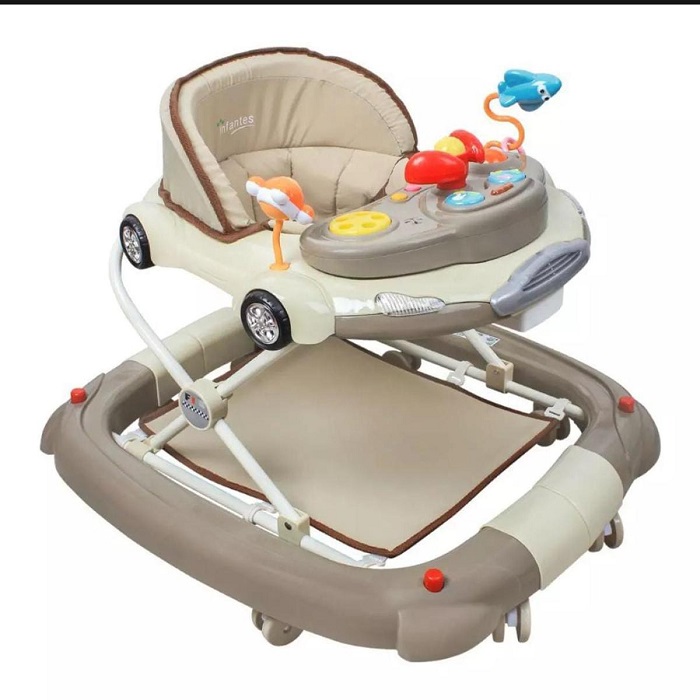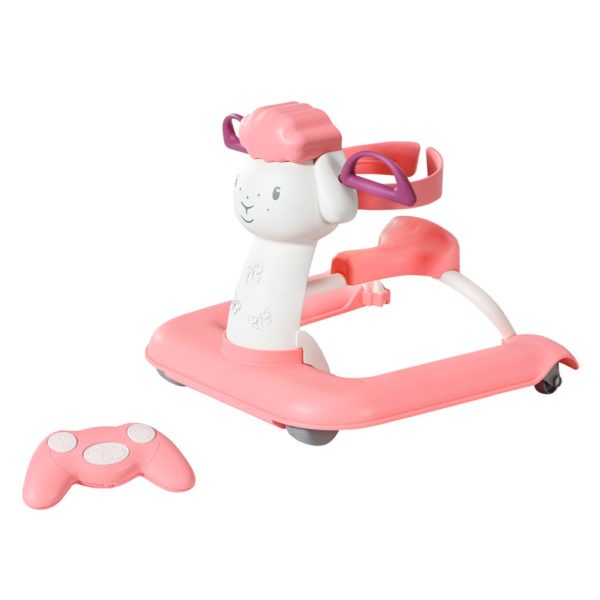Introduction to Baby Walkers
Baby walkers are devices designed to support infants who are not yet able to walk on their own. These products typically feature a base with wheels and a suspended fabric seat. They help little ones zip around by pushing off with their feet. Parents often look for a walker for baby as a way to encourage mobility and provide a form of entertainment.
Walkers for babies come in various styles and designs, offering a range of activities and experiences. Some have toys attached to the tray to engage the child’s senses and motor skills. Others are simple in design, focused only on helping the baby navigate space.
When introduced at the right age and with proper supervision, walkers for baby can be a delightful addition to a child’s playtime. However, they have been the subject of safety concerns. Experts advise to use them with caution and to prioritize safety features.
Before deciding on a baby walker, it is essential to understand its potential benefits and risks. This guide aims to provide comprehensive information on selecting a safe and suitable walker for your child. From safety precautions to key features and even alternatives, this guide covers what every parent should consider before making a purchase.
Safety Precautions for Baby Walkers

Ensuring your child’s safety should be the top priority when using a walker for baby. It is vital to adhere to safety guidelines and be aware of the risks associated with baby walkers. This section covers crucial safety measures to take before and during walker use.
Choosing Walkers With Safety Features
When selecting a walker for baby, look for models that come equipped with modern safety features. These may include:
- Wide base: To prevent the walker from tipping over.
- Friction strips: These reduce the chance of the walker moving over an edge or down the stairs.
- Locking wheels: To keep the walker stationary when needed.
- Safety certifications: Look for walkers that meet current safety standards and certifications.
Prioritize walkers with features designed to minimize accidents and enhance stability. Additionally, avoid walkers with sharp edges or small parts that could be a choking hazard.
Evaluating Home Environment for Walker Use
Before introducing a walker into your home, ensure that the environment is suitable:
- Remove hazards: Clear away items that the baby could knock over or get entangled with.
- Block off stairs: Use safety gates to prevent the walker from getting close to staircases.
- Flat surfaces: Use the walker in areas with flat floors to avoid uneven movements.
Survey your home environment with a critical eye to detect potential dangers, and adjust accordingly to create a safe space for your child to explore in their walker.
Key Features to Look for in a Baby Walker
When shopping for a walker for baby, pay attention to certain key features. They can enhance safety, provide comfort, and add enjoyment to your baby’s experience. Be sure to consider the following when selecting the perfect walker for your little one.
Adjustable Height and Comfort
The best baby walkers offer adjustable height settings. This allows the walker to grow with your child. A proper fit is crucial for safety and comfort. Look for padded seats that are soft and supportive. Comfortable seating can prevent irritation and discomfort during play.
Mobility and Wheel Design
Wheel quality directly impacts the walker’s ease of movement. Choose wheels suitable for your home’s flooring. Swivel wheels can offer better maneuverability. Ensure wheels are sturdy and smooth to allow for seamless motion across different surfaces.
Extra Features and Entertainment
Many baby walkers come with extra features to entertain your child. These can include toy panels, music, lights, and more. Such features keep babies engaged while they learn to move. However, simplicity can also be beneficial. Too many features might overwhelm your baby, so choose wisely.
Types of Baby Walkers

There are two main types to consider when choosing a walker for baby.
Sit-in Walkers vs. Push Walkers
Sit-in walkers are the classic style where babies are seated and use their feet to move around. They typically have a tray and are surrounded by a frame. Push walkers, on the other hand, help babies stand and take steps while pushing the device. They often double as activity centers on wheels.
Choose a sit-in walker if you want to support your baby before they can stand. For babies learning to walk, a push walker could be more suitable.
Theme-Based and Educational Walkers
Some walkers offer thematic or educational elements, like animal shapes or numbers. Educational walkers often have built-in games or puzzles to stimulate your baby’s learning. They can be either sit-in or push walkers.
Select a theme-based walker if you want to engage your child with specific characters or stories. For developmental benefits, look for educational walkers with activities that grow cognitive skills.
The Pros and Cons of Baby Walkers
When pondering if a walker for baby is right for your child, it’s crucial to weigh the pros and cons. Baby walkers are a popular choice for many families, but like any child product, they come with their set of advantages and disadvantages. Let’s explore them to help you make an informed decision.
Pros of Baby Walkers
High-quality baby walkers offer benefits that can be appealing to both the child and parents:
- Mobility Encouragement: Walkers for baby can motivate infants to move around and explore their surroundings.
- Play and Learn: Many walkers come with toys and games that aid in sensory and motor skill development.
- Happiness and Entertainment: Babies often enjoy the fun of moving freely in a walker, which can be a joyful sight for parents.
- Support and Safety: Properly selected walkers provide support for babies who are learning to walk, along with safety features to prevent accidents.
Cons of Baby Walkers
However, there are significant concerns associated with baby walkers that cannot be ignored:
- Risk of Falls and Injuries: If not used carefully, there is potential for serious accidents, especially around stairs or uneven surfaces.
- Developmental Delays: Experts warn that walkers can hinder natural walking and motor skill development in some babies.
- False Sense of Security: Parents might overestimate the safety of a walker and leave a baby unsupervised.
- Space and Clutter: Walkers take up space and can contribute to a cluttered home environment.
In summary, while a walker for baby can be a source of fun and stimulation, it’s essential to stay vigilant about the risks. Personal circumstances such as living space, supervision ability, and your child’s unique development stage should guide your choice in whether a baby walker fits into your family’s lifestyle.
Recommendations on Age and Usage Duration
When considering a walker for baby, age and usage duration are crucial factors to evaluate. These guidelines can help ensure your child’s experience with a baby walker is both safe and beneficial.
Ideal Age for Introducing a Baby Walker
The right age to introduce a walker varies with each baby, but typically falls within the range of 4 to 16 months. Babies should have sufficient neck strength to hold up their heads and show signs of readiness to explore movement. It is paramount to wait until your baby demonstrates the physical skills necessary for a walker.
Recommended Usage Duration
Limit walker use to short periods, such as 15 to 20 minutes at a time. Overuse of walkers can contribute to delays in natural walking abilities. Monitor how your baby interacts with the walker and adjust the duration accordingly. Providing breaks is essential to avoiding over-dependence on the walker for mobility.
By minding the age guidelines and restricting the time spent in a walker, you can tackle potential developmental concerns and promote a positive walking experience. Ensure that the introduction of a walker for baby aligns with your child’s growth and readiness for this new adventure.
Alternatives to Traditional Baby Walkers

While traditional sit-in or push walkers remain popular, there are alternative options for parents. These alternatives focus on safety and encourage natural development in infants.
Stationary Activity Centers
Stationary activity centers are a safe substitute. They have a seat for the baby, but no wheels. This means babies can bounce, spin, and enjoy toys without the risk of rolling away.
Baby Jumper
A baby jumper is another choice. It’s a seat attached to elastic straps. Your baby can use their legs to bounce and strengthen their leg muscles, all in one place.
Push Toys
Push toys encourage walking without confining the baby. They can hold onto the toy for balance as they learn to take steps. Push toys come in various fun designs and are often equipped with games.
Soft Structured Carriers
Soft structured carriers enable babies to experience movement as parents carry them around. It’s hands-free for the parent and simulates walking for the baby.
Crawling Mats
Crawling is essential for development. Mats with stimulating textures and colors encourage babies to move across the floor, helping to build their motor skills naturally.
When deciding whether to buy a walker for baby, consider these alternatives. They promote safety, encourage growth, and can be just as enjoyable for your little one.
Conclusion and Summary
In this guide, we navigated the complex choices surrounding a walker for baby. We’ve covered safety, key features to look for, and the types of walkers available. Safety is paramount when choosing a walker, and we highlighted the importance of picking one with modern safety features, such as friction strips, wide base, and locking wheels. The environment where the walker for baby will be used must be hazard-free and feature flat surfaces to ensure optimal safety.
For a great fit, we looked at walkers that offer adjustable height and comfort, ensuring that your child won’t just be safe but also comfortable. Wheel design is crucial for mobility, and we emphasized choosing durable and smooth wheels that match your home’s flooring. Extra features can provide entertainment and developmental benefits, but be mindful not to overwhelm your little one with too many stimuli.
We discussed the pros, such as mobility encouragement and support, against the cons, which include the potential for falls and the risk of developmental delays. It was noted that baby walkers should not be introduced before the child is physically ready, typically around 4 to 16 months, and usage should be limited to short intervals to prevent over-dependence.
Lastly, we explored alternatives to the traditional baby walker, such as stationary activity centers, baby jumpers, push toys, soft structured carriers, and crawling mats. Each offers different benefits that can aid in your child’s growth and development safely.
By carefully considering all these aspects, you can make an informed decision when selecting a walker for baby or deciding if an alternative path is better suited for your family. Remember that your child’s safety, comfort, and developmental stage are the most important factors in making this choice.